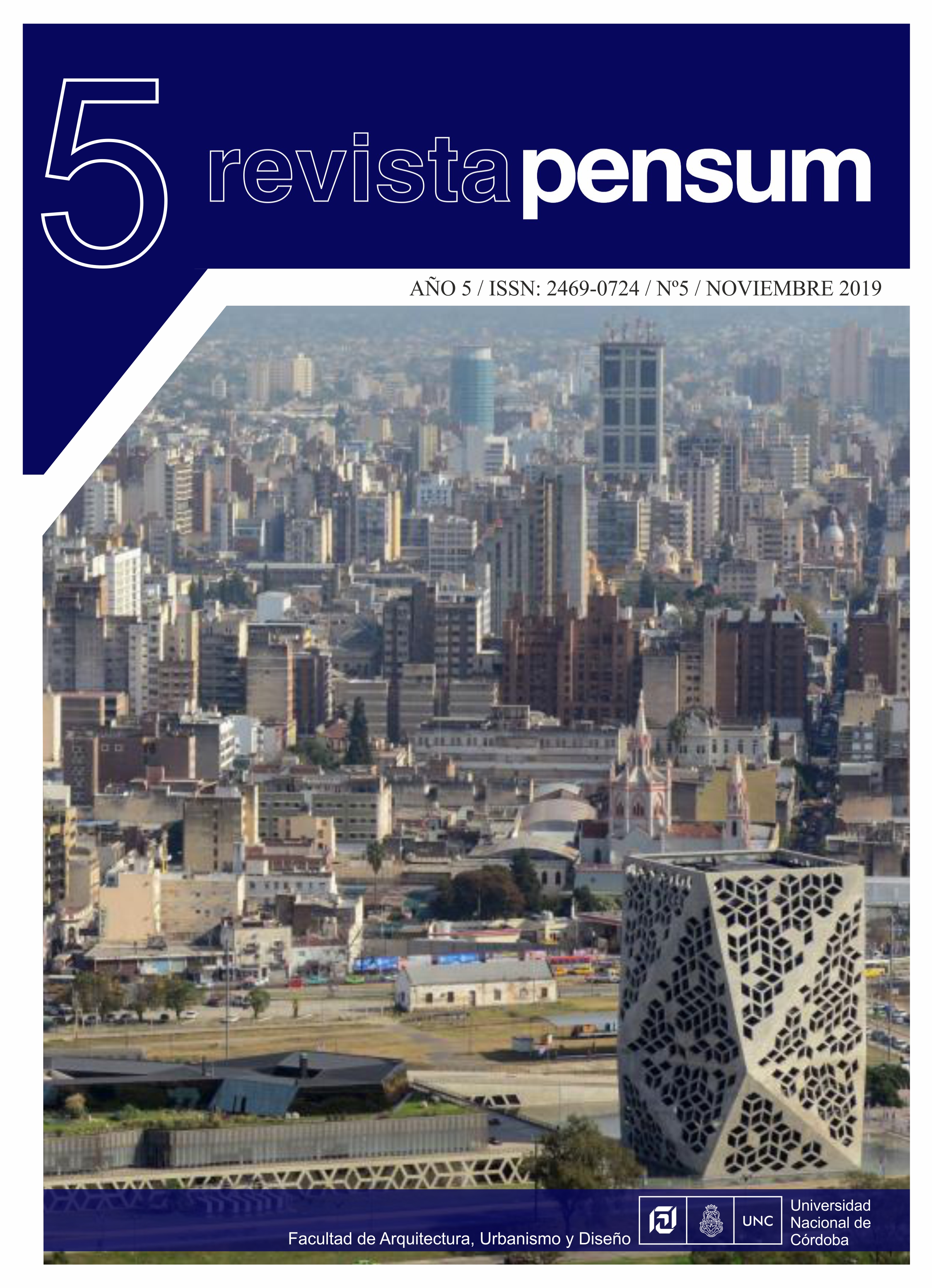Experimental research in design of construction elements using recycled materials to be used in social housing. Doctoral thesis synthesis
DOI:
https://doi.org/10.59047/2469.0724.v5.n5.26301Keywords:
Construction elements, construction mortar, ecology, recycled plastics, social housingAbstract
This article is a synthesis of a Doctoral Thesis of the Doctorate in Design Science at the Faculty of Architecture, Urbanism and Design of the National University of Córdoba, presented in 2009. It is about the development of a new material for construction: mortar made with recycled plastics and cement. With this material, bricks, blocks, plates and big bricks have been manufactured to be used as nonbearing enclosures in homes. These construction elements are more ecological than traditional ones because waste material is used as the main raw material, thus collaborating with the decontamination of the environment. Most of these residues up to the present are buried in the municipal land without any use; or accumulated and burned in landfills, causing degradation of the environment. From the technical point of view, construction elements are obtained with advantages over traditional ones (such as earth bricks and concrete blocks) in terms of lightness and thermal insulation. The economic importance of the implementation of this technology is that it will reduce costs for municipalities in waste collection and final disposal; and in general, in the decontamination of the environment.
Downloads
References
Avakian R. y Parekh S. (1991). Articles from mixed scrap plastics. Patente de EEUU. número: 5,073,416, propiedad de: General Electric Company, fecha de publicación: 17 de diciembre de 1991.
Berg V. y Rinno H. (1997). Concrete molding with improved acid resistance. Patente de EEUU número: 5,691,050, propiedad de: Hoechst Aktiengesellschaft (DE), fecha de publicación: 25 de noviembre de 1997.
Berretta, H. (1987). Vivienda y Promoción para las Mayorías. Editorial Humanitas, Buenos Aires, Argentina.
Betioli A., Silva D., Gleize P., Roman H. y Gómez L. (2004). Degradacao de fibres de PET em materiais a base de cimento Portland. Anales de la Primera Conferencia Latinoamericana de Construcción Sustentable-ENTAC04. Edición digital. San Pablo, Brasil.
Cáceres G., Giaccio G., Positieri M., Oshiro A. (2006). Utilización de residuos de procesos industriales en el hormigón. En Anales de la 16º Reunión Técnica de la Asociación Argentina de Tecnología del Hormigón. Editorial: Universidad Tecnológica Nacional, Facultad Regional Mendoza. ISBN 13: 978-987-21660-2-1. Mendoza, Argentina, pp. 31 - 38.
Cáceres Teran J. (1996). Desenvolupament Sostenible. Revista Tracte, 66, octubre de 1996.
Calvo, M. (2000). Tratado de reciclado y recuperación de productos de los residuos. Madrid: Ediciones MundiPrensa, pp. 31.
Fareed M., Asif A., Abbas H. (2007). Phisiochemical properties of polymer mortar composites using resins derived from post-consumer PET bottles. Cement and Concrete Composites, 29. Gran Bretaña: Editorial Elsevier, pp. 241248.
Fontein F. y Dreissen H. (1977). Process and installation for recovering usable materials from waste material containing metals and non metals. Patente de EEUU, número: 4,034,861, propiedad de: Stamicarbon B.V, fecha de publicación: 12 de Julio de 1977.
Gaiker Instituto Tecnológico. (1996). Catálogo de productos. Barcelona, España.
Gobierno de la Provincia de Buenos Aires. Coordinación Ecológica Área Metropolitana Sociedad del EstadoCEAMSE (1992). Publicaciones periódicas CEAMSE, 1992. Editorial: Gobierno de la Provincia de Buenos Aires, Argentina.
Gobierno de la Provincia de Córdoba. Agencia Córdoba Ambiente (2000). Diagnóstico Provincial de los sistemas de gestión de residuos sólidos urbanos. Editorial: Gobierno de la Provincia de Córdoba.
Gobierno de la Provincia de Córdoba. Agencia Córdoba Ambiente. (2001). Programa Córdoba limpia. Córdoba: Editorial: Gobierno de la Provincia de Córdoba, Argentina.
Gobierno del Estado de México. (2004). Cuánto tiempo tarda la naturaleza en transformar… Publicación digital del Programa México Limpio, del 17 / 09 / 2004. México.
Hammond J. y Warren S. (1999). Pre-fabricated building system for walls, roofs and floors using a foam core building panel and connectors. Patente de E.E.U.U. número: 5,921,046, propiedad de: Recobond Inc., fecha de publicación: 13 de Julio de 1999.
Han E. (1996). Pre-fabricated title board. Patente de EEUU, número: 5,816,005, fecha de publicación: 4 de Setiembre de 1996.
Hoedl, H. (1991). Manufacture of molded composite products from scrap plastics. Patente de E.E.U.U. número: 5,075,057, fecha de publicación: 24 de diciembre de 1991.
Idelsohn, A. (2003). Hacer con desechos. Revista Nueva, 628, Julio de 2003, pp. 16-19, Córdoba, Argentina.
Jenkins, R. (1994). Waste treatment process. Patente de EEUU, número: 5,302,331, fecha de publicación: 12 de Abril de 1994.
Kibert C. (1994). CIB-TG16. First International Conference on Sustainable Construction Acts, Florida, E.E.U.U.
King, B. (2005). Movimiento de construcción ecológica en EEUU. Ponencia presentada en la III Conferencia Internacional de Ecomateriales, Santa Clara, Cuba, octubre de 2005.
Kruk W. (2001). Construyendo con lo que se descarta. Vivienda Popular, 8. abril de 2001, pp. 33-35. Montevideo, Uruguay.
Lanting, R. (1996). Sustainable Construction in The Netherlands-A perspective to the year 2010. Working paper for CIB W82 - Future Studies in Construction. TNO Bouw.
Lupo J. y Tre L. (1999). Rubber composition obtained by recycling scrap material. Patente de EEUU, número: 5,948,827, fecha de publicación: 7 de Setiembre de 1999.
Magnani, S. (1991). Cement mix and method for producing reinforced building sheets from a cement mix. Patente de EEUU. número: 5,030,287, propiedad de: Fibronit S.R.L., fecha de publicación: 9 de Julio de 1991.
Nagayasu, N. (1989). Method for producing composite material of plastic and rubber. Patente de EEUU, número: 4,795,603, fecha de publicación: 3 de enero de 1989.
Nicod, G. (1990). Paneaux isolants pour Bariloche. Un projet d’Ingenieurs du Monde. Polyrama N. 87, diciembre de 1990, Escuela Politécnica Federal de Lausana, pp.8-9.
Nosker, T. y Renfree, R. (1998). Composite building materials from recyclable waste. Patente de EEUU, número: 5,789,477, propiedad de: Rutgers, The State University, fecha de publicación: 4 de agosto de 1998.
Porter W. (2001). Asymmetric structural insulated panel. Patente de EEUU, número: 6,205,729, fecha de publicación: 27 de marzo de 2001.
Prusinski, R. (1984). Thermoplastic polymer concrete structure and method. Patente de EEUU, número: 4,427,818, fecha de publicación: 24 de enero de 1984.
Raponi D. (1977). Cementitious composition. Patente de EEUU, número: 4,058,406, fecha de publicación: 15 de noviembre de 1977.
Rebeiz, K. (1996). Precast use of polymer concrete using unsaturated polyester resin based on recycled PET waste. Construction and Building Materials, 10 (3). Inglaterra, Editorial Elsevier, pp. 215-220.
Rebeiz K. (1995). Time-temperature properties of polymer concrete using recycled PET. Cement and Concrete Composites, 17, Editorial Elsevier, Inglaterra, pp. 119-124.
Sawyers J. (1995). Method for recycling plastic into cementitious building products. Patente de EEUU, número: 5,422,051, fecha de publicación: 6 de junio de 1995.
Spakousky J. (1999). Building block with insulated center portion. Patente de EEUU, número: 5,983,585, fecha de publicación: 16 de noviembre de 1999.
Published
How to Cite
Issue
Section
License

This work is licensed under a Creative Commons Attribution-ShareAlike 4.0 International License.
Authors who publish in this journal agree to the following terms:
a. Authors retain copyright and guarantee to the journal the right to be the first publication of the work as well as licensed under a Creative Commons Attribution-ShareAlike 4 license.
b. Authors may separately establish additional agreements for non-exclusive distribution of the version of the work published in the journal (e.g., placing it in an institutional repository or publishing it in a book), with an acknowledgement of its initial publication in this journal.
c. Authors are permitted and encouraged to disseminate their work electronically (e.g., in institutional repositories or on their own website) before and during the submission process, as this may result in productive exchanges, as well as earlier and greater citation of published work (See The Effect of Open Access).
d. 4.0 International Creative Commons Attribution-ShareAlike 4.0 License.












